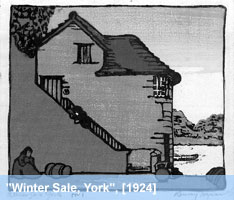
|
TEACHING TOOLS Ramsay Traquair used various media illustrating to his students the art and science of craftsmanship. These different tools include woodcuts, stained glass, and lectures embellished by glass slides. WOOD CUTS Very little is known about Traquair's teaching notes on woodcuts, although the Department of Rare Books and Special Collections (RBD) possesses five loose prints designed by Traquair, as well as the two original wood blocks used to print a series woodcut. This series shows a "set of prints illustrating the printing of a coloured woodcut from a number of wood-blocks. Each colour is printed by hand from a separate block" (Caption 3). STAINED GLASS The stained glass window entitled Winter was used by Traquair to demonstrate the art of the technique. Two such lectures, stored by the McGill University Archives, were given by him at McGill University: "Stained Glass I: Technique" (8p. manuscript) and "History of Stained Glass" [8p. manuscript]. First and foremost, stained glass is described by Traquair to be called a transparent mosaic, not a picture, that is a medieval product. If the function of the basic window is to let in light, then the stained glass window renders this light interesting and beautiful. The coloured piece of glass should be preserved with minimal painting to retain its jewel-like quality. Each colour must have its own piece of glass, fragments that are brought together with strips of lead called cames. These vary in thickness from approximately ½" to 7/8" (exception: white glass may be shaded with yellow; blue glass may patterned with green, etc.). The junctions of the cames should be at right angles as much as possible not to look clumsy. A full-size image is drawn on a sheet of tracing cloth producing a cut line diagram, it is from this that the pieces of glass will be cut and the lines show where the cames will be placed. The best glass is cut into pieces about 7" x 9" x 10" high. Saddle bars (iron, bronze, or gunmetal) are required to stiffen stained glass that is larger than 2' x 3'. Coloured glass exists as pot metal (coloured throughout) or flashed glass (white glass with 1/8" of colour on one side), with the former being the superior of the two. The chosen pieces of coloured glass are fixed in place with beeswax on the cut line diagram. When the painting is done, the glass is burnt to affix the paint onto the glass, usually 3 paintings and 3 firings. Then the lead is added and soldered together. GLASS SLIDES The John Bland Canadian Architecture Collection holds 1,203 glass slides from various provinces with 179 devoted to Canadian architecture and planning, general ornamentation and decoration. These glass slides were produced for Traquair's and Nobbs' courses in the School of Architecture. A selection of these slides gives a hint to which topics Traquair felt were pedagogically valuable. The history and theory of planning city spaces was important for a global understanding of architectural intervention [1]. Craftsmanship is what made the building: joinery, masonry details, and cabinet detailing [2]. The way in which a roof met the wall and its variations were not to be neglected [3]. Theoretical aspects such as human proportion, column spacing and diametres, and pure geometry of forms were instructed [5][6][7]. Above all, drawing was a necessary skill to enable architects to express their ideas, either two-dimensionally or three-dimensionally [4][8].
|
|
Digital Collections | © 2003, McGill
University
|
|
|
|
|
|
|
|
|
|
|
|
|
|
|
|
|
|
|
|
|
|
|
|
|
|
|